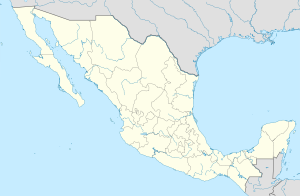San Fernando massacre
The place of the massacre. |
The San Fernando massacre was a mass murder of 72 Latin American migrants on August 24, 2010 in connection with the drug war in Mexico . The victims were u. a. from Brazil , Ecuador , Honduras , Guatemala and El Salvador . Only two of the victims survived the incident.
The bodies of those killed were discovered after a shooting with members of the Los Zetas gang in a hacienda near the city of San Fernando in the Mexican state of Tamaulipas . It was the largest massacre in Mexico's recent past.
background
Many emigrants want to emigrate to the USA via Mexico . 43,700 illegal immigrants were picked up and deported between January and July 2010. At least 10,000 of them were abducted between October 2008 and September 2009 (the Inter-American Commission on Human Rights (CIDH) estimates 18,000 per year). The purpose is mostly the extortion of ransom from their families or forced prostitution . According to NGOs, the Zetas alone raised 18 million dollars in this way from 2006 to 2010. The crimes are seldom exposed because migration authorities, police officers and the drug mafia often work closely together.
course
massacre
The migrants were stopped by eight armed men on August 21 on their way to the US border . They took them to the farm in several vehicles, where they were handcuffed behind their backs. Since they refused to take care of logistical tasks and to pay again for the passage to the USA because they had already paid in their home countries, they were murdered. They were blindfolded and had to lie down. Then they were shot with automatic fire guns.
Attempted arrest
An 18-year-old Ecuadorian who was believed to have been the only survivor of the massacre for a few days alerted the Mexican armed forces on August 24 . The perpetrators thought he was dead and he was therefore able to flee to an armed forces checkpoint with a gunshot wound in the neck. The Marines advanced with air support and involved the gang members present in a gun battle lasting several hours in which three criminals and one soldier died. A young gang member was arrested. The rest of the Los Zetas fled. In addition to those murdered, numerous weapons, uniforms and vehicles were discovered on the site.
Disappeared investigators and manhunt
According to the government's first account, the perpetrators were Los Zetas members who are said to have fought a dispute with the Gulf cartel .
Two officers in charge of the case (Juan Carlos Suárez Sánchez, a senior police officer, and Roberto Jaime Suárez Vázquez, a public prosecutor) disappeared the day after the massacre. The two decapitated bodies were found on August 27 in the village of Méndez , near the crime scene. Seven people allegedly involved in the massacre were arrested on the same day. According to the national security spokesman Alejandro Poiré , these belong to the Los Zetas.
Victim
The victims come from Brazil, Ecuador, Honduras, Guatemala and El Salvador and wanted to enter the USA via Mexico . There are 14 women and 58 men. Diplomatic representatives from El Salvador, Ecuador and Brazil came to Tamaulipas on August 26 to help with identification. On August 30, 31 dead were identified, including 14 from Honduras, 12 from El Salvador, 4 from Guatemala and one from Brazil.
In addition, three criminals and one soldier died in the exchange of fire. Two officers involved in the case were murdered.
On September 2, it became known that, in addition to an 18-year-old Ecuadorian, another person survived the massacre. In order not to endanger him, the authorities kept his identity a secret.
Reactions
Alejandro Poiré, security spokesman for the Mexican government, spoke of the weakness of the drug cartels in connection with the massacre.
Mexico's Foreign Minister Patricia Espinosa Cantellano spoke of a cowardly act and expressed her sympathy for the relatives. The Ecuadorian Foreign Minister Ricardo Patiño condemned the crime and his colleague from El Salvador, Hugo Martínez , said he hoped the perpetrators would be caught.
Mexican President Felipe Calderón condemned the massacre and blamed the drug cartels in the region.
On September 14, 2010, Cecilia Romero , the then head of the immigration office, resigned due to criticism of the handling of migrants passing through in Mexico.
Others
In April 2011, after the arrest of eleven suspected kidnappers, eight mass graves with at least 60 bodies were found in the immediate vicinity of the site of the massacre.
Individual evidence
- ↑ a b c d Mexico: Second survivor of massacre. In: ORF , September 2, 2010.
- ↑ a b c d Cecibel Romero: 72 migrant workers executed. In: the daily newspaper , August 26, 2010.
- ↑ a b c d e f Horror at the massacre in Mexico. In: Frankfurter Allgemeine Zeitung , August 27, 2010.
- ↑ 18-year-old survived the massacre as the only witness. In: Spiegel Online , August 18, 2010.
- ↑ a b c 72 migrants murdered. In: Süddeutsche Zeitung , August 26, 2010.
- ^ A b c Wolf-Dieter Vogel: Political victim of a massacre. In: the daily newspaper , September 16, 2010.
- ↑ Bloody battle over the drug ranch. In: the daily newspaper , September 3, 2010.
- ↑ a b c Identification of the 72 bodies in Mexico has begun. In: Neue Zürcher Zeitung , August 27, 2010.
- ^ A b Nicholas Casey, José de Córdoba: Mexico Arrests 7 In Migrant Killings. In: Wall Street Journal , September 8, 2010.
- ↑ a b c Investigators disappeared for the massacre in Mexico. In: ORF , August 27, 2010.
- ↑ Klaus Ehringfeld: USA get involved. In: Frankfurter Rundschau , September 9, 2010.
- ↑ a b Two investigators of the immigrant massacre apparently disappeared. In: Spiegel Online , August 27, 2010.
- ↑ Eight mass graves found. In: the daily newspaper , April 7, 2011.
